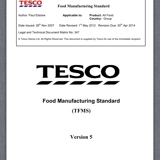Title Page
-
Site conducted
-
Conducted on
-
Prepared by
Assessment
Positive Findings
-
Note item that you find and like while assessing the facility
- Good Job
- Good Job Share with other facilites
-
Note item that you find and like while assessing the facility
- Good Job
- Good Job Share with other facilites
-
Note item that you find and like while assessing the facility
- Good Job
- Good Job Share with other facilites
-
Note item that you find and like while assessing the facility
- Good Job
- Good Job Share with other facilites
-
Note item that you find and like while assessing the facility
- Good Job
- Good Job Share with other facilites
Training and Engagement
-
Is the site up to date on their monthly safety training?
-
How is the training conducted ? classroom vs. individual online
-
Who is responsible for conducting the training?
-
when do you conduct your weekly shop talks? (day of the week and time)
-
How are your shop talks conducted?
-
Does your site have an active safety committee?
-
What is your plan to address this?
-
ask to see the notes from the most recent meeting
Incident and Near Miss Management
-
Does the site have a near miss program?
-
Do the supervisors know where to find the documentation to update their incident packs?
-
Does the shop have incident packs accessible for the leads/SME's
JHA
-
Does the site have JHA's in place?
-
Are the JHA's being reviewed and updated Annually?
-
Are you reviewing and updating the JHA's after incidents and significant near misses
-
When was the last one updated?
Concerns
General Managers and Supervisors
-
Ask the General Manager what safety concerns do you have regarding your site ? What keeps you up at night about your job
-
Ask the Department Supervisor what safety concerns do you have regarding your departmen/shop ? What keeps you up at night about your job
Employees
-
Ask the employee what concerns you about your job ? What keeps you up at night about your job
-
Ask the employee what concerns you about your job ? What keeps you up at night about your job
-
Ask the employee what concerns you about your job ? What keeps you up at night about your job
Safety Team Concerns
-
Are there any concerns that you have at the site that are not a part of the assessment
-
Are there any concerns that you have at the site that are not a part of the assessment
-
Are there any concerns that you have at the site that are not a part of the assessment
-
Are there any concerns that you have at the site that are not a part of the assessment
House Keeping
-
Are slippery conditions eliminated in designated walkways and working surfaces?
-
Is the a mechanism in place to address any slippery conditions ie oil dry
-
<br>Are obstructions, such as nails, pallets, holes, tools, materials, equipment, or lose boards eliminated from walkways and working surfaces to allow for adequate passage?
-
Are passageways, walkways, and working surfaces kept clear of steel shot or similar abrasives that may create a slipping hazard?
-
Are aisles and passageways marked and kept clear?
-
ask the employee to walk you through how people navigate when walking through those areas
-
Are hoses and electrical service cords positioned to prevent injury to workers or damage to the hoses and cords themselves (e.g., crossover planks, beneath grating, stowed overhead)?
-
<br>Are doorways, emergency exits, fire protection equipment, electrical panels, eyewash stations, and safety showers free from obstructions?
-
Is adequate lighting provided in work areas?
-
<br>Are exit routes clearly marked “Exit,” as well as indicating the direction of travel to the exit, if not immediately apparent?
-
Are exits markings and lighting adequate and appropriate?
General Environmental Cotnrols (Sanitation)
-
Are waste containers emptied regularly?
-
Have areas where water drains exist been cleared of debris ?
-
When was the last time they were cleaned?
Vermin Control
-
Is there a vermin control program in place that is maintained?
-
Is the area free of rodents, insects, and vermin?
-
Note areas where you see or see evidence of vermin
Fire Protection and Prevention
-
Are portable fire extinguishers provided, mounted, located and identified so that they are readily accessible to employees?
-
Do you have a third party come in and check your fire extinguishers annually ?
-
Are annual maintenance checks of portable fire extinguishers completed and records maintained of the date completed?
-
Note the response and follow up with recommendations
-
Are portable fire extinguishers visually inspected each month?
-
find out who is responsible fore inspecting monthly and note below
-
Are sprinkler systems inspected annually to assure that the system is maintained in good operating condition? (note ask IT if the server room has been checked )
-
if in Illinois the distance is 15 ft from the entrance. In TN the distance is 125ft In Indiana the distance is 8ft
-
Are approved smoking areas the proper distance from common entrances ?
-
Is there any evidence of smoking in the shop or while operating power equipment ?
Eyewash station inspection
-
are eye wash facilities and quick drench showers available within the worksites where employees are exposed to dangerous corrosive materials
-
Is the area around the station clear of obstructions
-
are there any leaks
-
is the water clear?
-
Where plumed stations are used are they checked weekly?
-
who checks them?
Personal Protective Equipment
-
Are affected employees using appropriate eye or face protection while performing their job duties (exposed to eye or face hazards from flying particles, molten metal, liquid chemicals, acids or caustic liquids, chemical gases or vapors, or potentially injurious light radiation?)
-
What is the site steel toe shoe policy
Fall Protection
-
is there ever a time where an employee needs to use a full body harness?
-
Does the employee have their own harness?
-
Is the harness in good condition?
-
How may do you have on hand
-
What type of lanyard do you use (retractable vs Bungee)
Hand Protection
-
Are gloves used in the facility
-
What Type and where
-
Is the hand protection in use the appropriate for the job?
-
Are the gloves being used in good repair i.e. free from holes cracks and other damage
Hearing
-
Is hearing protection required in this facility?
-
Why not ?
-
Where must hearing protection be worn?
Head Protection
-
NOTE: this question applies when working with the travel lift and/or during crane testing
-
Are there instances where head protection is in use/required
-
In what instances are hard hat used?
-
Are your Hard Hat's current - 5 years from date listed
Respirators and Weld hoods
-
Are the respirators stored in a way that will protect them from contamination, heat, extreme temperatures and other damage?
-
Do you have any instances where personnel are share respirators
Hand and Power tools
-
Are all portable power tools properly grounded?
-
confirm if the equipment has an internal grounding mechanism (double insulation) with manager/supervisor/lead/SME
-
Do air nozzles meet OSHA requirements ? emit not more than 30 psi has nozzel pressure reducing mechanisim.
-
Are portable power tools equipped with appropriate guards where applicable ? rotating parts, pinch pints must be guarded
-
Are portable grinders completely and adequately guarded?
Bench Grinders
-
Are bench grinders set to the required width (no more than an 1/8" of space from the tounge)
-
Are bench grinders properly guarded?
Hazardous Materials
-
Are fire control devices located in areas where flammable liquids are stored or used?
-
Are flammable and combustible liquids stored properly ?
-
Are power shut-off controls for fuel pumps remotely located, clearly identified, and readily accessible?
-
Are all secondary chemical containers properly labeled? (add document that shows what properly is)
-
Are signs posted to prohibit smoking in fueling areas or where flammable or combustible liquids are received, dispensed, or stored?
-
Are “No Smoking” signs conspicuously posted at all paint spraying areas and paint storage rooms?
Compressed gas cylinders
-
Are all compressed gas cylinders legibly marked to indicate their contents?
-
Are cylinders stored in upright position and immobilized by chains or other means to prevent them from falling to prevent damage and tampering?
-
ask various employees what their process is and the equipment they use to move them.
-
How do you move the compressed gas cylinders from one location to the next
-
Are oxygen and acetylene stored separately (20 ft distance)
Welding Cutting Brazing
-
Do we ever reuse drums, barrels, tanks, or other containers that contained flammable materials, or materials that may produce flammable or toxic vapors when heated?
-
Do we do any type of work that would require us to weld in a confined space ? (provide example)
-
In what instances are we doing this type of work?
-
Are confined spaces adequately ventilated to prevent the accumulation of toxic materials or oxygen deficiencies during welding or cutting operations?
-
Have all fire hazards in the vicinity of welding or cutting been removed or guarded? (trash, paper, carboard)
-
Are the welder and any helpers or attendants using properly selected helmets, goggles, or face shields during any welding, cutting, or brazing operation?
-
Ask the employee who weld/cut/braze where is the closest first aid cabinet ?
-
What kind of ventilation is provided in welding or cutting areas?
-
Ask the employee: when Welding what do you ground to?
-
Are the lead cables for electrical arc welding units free from splices or open insulation ?
Electrical
-
Are electrical cords, outlets and plugs in good condition ?
-
Are there any areas where extension cords are being used as a permanent wiring solution ?
-
What is the plan to eliminate the extension cord use
-
Are there any areas where 3 way plugs are being used as a power source for equipment ?
-
Are all pull boxes, junction boxes, and fittings provided with covers are in good condition?
-
Do all electrical panels and power distribution cabinets have a minimum of 3 feet of clear space in front of them?
-
Are electrical outlet, cords, etc. in or near wet areas an approved type for the environment? (ie. GFI)
-
Are all electrical circuit controls, breakers, fuses and disconnects marked to show what they control?
Lifting Devices
Cranes (overhead, jibs, etc)
-
Are Daily Crane checklist completed ?
-
What do you do with the check lists when completed?
-
If there is an issue found what happens next?
-
what are go no go findings that require a shut down of the crane?
-
Are the control pendants properly marked?
-
Do you have an outside vendor inspect your cranes annually
Hoists, Hooks, Slings and Chain Lifts
-
Are Strong backs visibly marked with load rating ?
-
Are all hoists and chain lifts visibly marked for maximum load capacity?
-
Are chains, slings and wire ropes for hoists in good condition free from any visible damage?
-
Are annual inspection done on your slings and chains ?
-
Is your rubber tire gantry crane visibly marked with Load rating
-
Do hoist hooks on come-alongs have safety latches in working order?
Magnets
-
Are all magnets in good working order ?
-
Is there any type of inspection/PM program for the magnets
-
who is responsible for the inspection/PM?
-
How often is it completed?
-
Who is responsible for the PM program?
-
Powered Industrial Vehicles
-
Have the daily VCR's been completed on all powered industrial vehicles (forklifts, aerial lifts, scissor lift etc)
-
If there is an issue with the forklift who does it get reported to and what are the next step
-
When are the VCR's are filled out
-
Who gets the completed check lists
-
Where and how long are the kept
-
what are the go/no go sections of the check list
-
Are the Powered equipement drivers operating in a safe manner
-
Is there a document that provides a listing of approved operators with the anniversary date of their required evaluation / training?
-
When aerial and scissor lifts are in use is the area below marked off to prevent pedestrians from walking underneath it.
Machine Guarding
-
Are there any pieces of equipment that require some type of guard ?
-
do the pieces of equipment have point of operation guarding in place where needed?
-
Note the name and location of the equipment
-
Do all pieces of equipment have point of operation guarding in place?
-
Do saws, drill presses, or other fixed equipment have means provided to secure them in place, or are secured to a portable table?
Paint Department Specific
-
Does the site have Paint operations
-
Do all electrical wiring and equipment located in or near paint kitchen areas comply with National Electrical Code provisions for hazardous locations?
-
Is there any evidence of painting outside of the paint booth
-
ask the department manager/supervisor why this is occurring and how it is managed
-
Are there any 55 gallon drums containing flammable liquids sitting outside of the paint booth/kitchen?
-
When were drums received ?
-
1910.106(e)(2) "Incidental storage or use of flammable liquids" 1910.106(e)(2)(ii)(b) The quantity of liquid that may be located outside of an inside storage room or storage cabinet in a building or in any one fire area of a building shall not exceed: 25 gallons of Call IA liquids in containers, 120 gallons of Class IB, IC or II or III liquids in containers , 660 gallons of class IB, IC, II or III liquids in a singe portable tank.
-
What is the shops process to clean spray nozzles
-
When do you change the paint booth filters? What is the mechanism you use to identify the change needs to occur?
-
How do you identify if the gages on the paint booth/blast bay are working? i.e. is there a PM system or is there a 3rd party vendor.
-
Has the supplied air to the paint booth and blast bay been tested?
-
how often is it tested
-
Can employees working in the paint and blast booths hear the emergency evacuation notifications.
-
What is the process used to clean the paint shop floor?
-
Does the paint booth have a visible gauge/manometer, audible alarm or pressure activated device?
-
please note: 29 CFR 1910.107(g)(2):Cleaning. All spraying areas shall be kept as free from the accumulation of deposits of combustible residues as practical, with cleaning conducted daily if necessary. Scrapers, spuds, or other such tools used for cleaning purposes shall be of non-sparking material.
-
Where breathing air is supplied to respirators used by paint team is there evidence (i.e. tags) of routine maintenance/checks on the compressors?
Confined Space
-
Has the shop identified any permit and/or non permit required confined spaces
-
Are the confined spaces labeled
-
Does the site have a written confined space program
-
Have affected employees been trained on the confined space program
Material handling and Storage
-
Are the storage racks secured to the ground?
-
Are items stored on the top of the rack secured to prevent falling
-
Are materials stacked in a manner where they are stable when stored in Racks, on the floor and/or on the equipment while moving?
-
Is good housekeeping maintained in storage areas?
-
Are load limit weights posted in the storage areas/racks?
-
Are the racks standing plumb and level?
-
Are components rusted or corroded?
-
Is the rack showing signs of being overloaded?
-
Are the uprights bent or damaged?
-
Are there pallet stops or guards in place where there is a single storage rack adjacent to service aisles?
-
Is there overhead guarding at tunnel bays?
-
Are the beams seated tightly into the uprights?
-
Are there any dents, distortions or evidence of an impact?
-
are there any pallets over-hanging, double stacked, or damaged in the racks?
-
Are the pallets the correct size for the rack?
Docks
-
Is the dock well-lit or are there working dock lights at each bay?
-
Is the dock area clear of debris, spills, oil , rain/ice ?
-
Are there fire extinguishers available?
-
Are the docks closed and/or locked when not in use ?
-
Are dock barriers in use?
-
What is the proceudure for unloading /loading a trailer?
-
Are chocks or dock locks used?
-
are chocks/dock locks in good condition?













